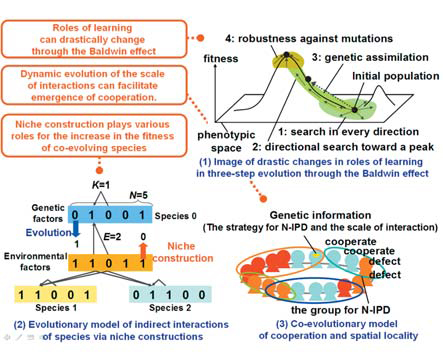Comprehensive List of Researchers "Information Knowledge"
Department of Complex Systems Science
- Name
- SUZUKI, Reiji
- Group
- Emergent Systems Group
- Title
- Associate Professor
- Degree
- Dr. of Philosophy
- Research Field
- Artificial life / Agent-based modeling / Evolutionary computation

Current Research
Understanding Adaptive Dynamics by Creating Emergence within Computers
OUTLINEEmergence, that is, the occurrence of higher level features from local interactions of elements, is one important topic in complex systems studies. Our mission is to investigate the general principles of emergent dynamics in evolving biological or social populations through the creation of emergent phenomena within computers by constructing artificial life models that consist of many locally interacting agents.
TOPICS
(1) Interactions between evolution and learning
Evolution and learning are different adaptive mechanisms that occur on different levels (population or individual) in biological populations. The Baldwin effect is one possible scenario of interactions between these mechanisms, where individual lifetime learning can guide the genetic acquisition of learned traits without the Lamarckian mechanism. We investigated how this effect occurs in dynamic or complex environments. For the former, we adopted the iterated Prisoner's Dilemma as a dynamic environment, introduced phenotypic plasticity into its strategies, and conducted evolutionary experiments. We found that a cooperative and robust strategy with a modest amount of phenotypic plasticity emerged through the Baldwin effect. For the latter, we constructed an evolutionary model of quantitative and plastic traits with epistasis by using an extended version of Kauffman's NK fitness landscape. The results showed that drastic changes in roles of learning caused three-step evolution through the Baldwin effect and also caused the evolution of genetic robustness against mutations.
(2) Interactions between evolution and niche construction
Niche construction is the process whereby organisms, through their metabolism, activities, and choices, modify their own and/or each other's niches (source of selections). To clarify indirect interactions among species by niche construction of their shared environments, we constructed a new fitness landscape model termed the NKES model by introducing environmental factors and their interactions with genetic factors into Kauffman's NKCS model. Results showed that niche construction increased the average fitness among species by playing various roles depending on the ruggedness of the fitness landscape and the degree of the niche construction effect on genetic factors. We are also investigating the effects of spatial locality on the evolution of niche construction by using a spatial model of the evolution of strategies for Prisoner's Dilemma in which niche constructions modify the payoff for success in cooperation. We found that the evolution of a niche-constructing gene was strongly affected by the degree of spatial locality of niche construction.
(3) Coevolution of cooperation and structure of interactions
It is known that the structure of interactions can affect the emergence of cooperative behaviors. We focused on two essentially distinct factors of spatial locality : the scale of interaction (which decides neighboring members for games) and the scale of reproduction (which decides candidate individuals for offspring in each position). We conducted evolutionary experiments of strategies for a one-dimensional N-person iterated Prisoner's dilemma with various settings of these two factors. The results revealed that these two factors brought qualitatively different effects to the emergence of cooperation. Furthermore, the introduction of the evolution of the scale of interaction facilitated the emergence of cooperation when the scale of reproduction was relatively small. Currently, we are investigating another simple model for the coevolution of cooperation and network in which the strategy for rewiring the neighboring network structure of interactions can evolve.
FUTURE WORK
In addition to detailed investigations into these topics, we will consider engineering applications of emergent mechanisms.

Figure : Models and image of evolutionary dynamics
Career
- 2003 received a Ph.D. degree from Graduate School of Human Informatics, Nagoya University.
- 2003-2007 A research associate of the Graduate School of Information Science, Nagoya University.
- 2007-2010 An assistant prefessor of the Graduate School of Information Science, Nagoya University.
- 2010-present An associate prefessor of the Graduate School of Information Science, Nagoya University.
- 2010-(2011) Visiting scholar at Department of Ecology and Evolutionary Biology, University of California, Los Angeles,
Academic Societies
- International Society of Artificial Life
- Japanese Society for Artificial Intelligence
- Information Processing Society of Japan
- Japanese Society for Mathematical Biology
- Society of Evolutionary Study, Japan
Publications
- Reiji Suzuki and Takaya Arita: Evolution of Cooperation on Different Pairs of Interaction and Replacement Networks with Various Intensity of Selection, International Journal of Bio-inspired Computation (in press).
- Reiji Suzuki, Masanori Kato and Takaya Arita: Cyclic Coevolution of Cooperative Behaviors and Network Structures, Physical Review E (Selected for Virtual Journal of Biological Physics Research, Vol. 15, Issue 5, March 1, 2008), 77(2), 021911 (7 pages) (2008).
- Reiji Suzuki and Takaya Arita: The Dynamic Changes in Roles of Learning through the Baldwin effect, Artificial Life, 13(1), 31-43 (2007).
- Interactions between Learning and Evolution: Outstanding Strategy Generated by the Baldwin Effect, Biosystems, 77 (1-3), 57-71 (2004).








